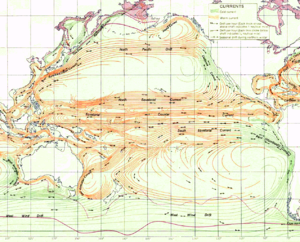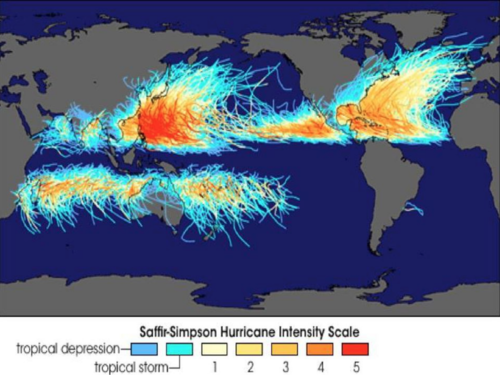Difference between revisions of "Coriolis Effect (Weather)"
Tom Bishop (talk | contribs) |
Tom Bishop (talk | contribs) |
||
| Line 24: | Line 24: | ||
- [https://youtu.be/hUBocmQil00?t=135 Dinner Plate Creates Counter-Rotating Vortexes in a Swimming Pool] (2m20s) | - [https://youtu.be/hUBocmQil00?t=135 Dinner Plate Creates Counter-Rotating Vortexes in a Swimming Pool] (2m20s) | ||
| − | The same general phenomena seen in the fluids of water in the above videos are occurring with he fluids of the air near the equator, caused by the Equatorial Counter Current, which flows in an opposite direction of its neighboring Northern and Southern currents. A "Coriolis Effect" is not needed. | + | The same general phenomena seen in the fluids of water in the above videos are occurring with he fluids of the air near the equator, caused by the Equatorial Counter Current, which flows in an opposite direction of its neighboring Northern and Southern currents. And, when comparing the direction of the vortexes in the above video with the direction of the plate and spoon, to the direction of the Equatorial Counter Current, we find that, indeed, the directions match up. |
| + | |||
| + | A "Coriolis Effect" is not needed. | ||
==Origin of Hurricanes== | ==Origin of Hurricanes== | ||
Revision as of 23:02, 9 October 2018
Work in Progress
According to proponents of the Coriolis Effect, in the Northern Hemisphere wind systems rotate counter-clockwise, and in the Southern Hemisphere wind systems will rotate clockwise. This is provided as evidence of the Coriolis Effect, and therefore, as evidence of the diurnal motion of the earth.
Prevailing Winds and Trade Winds
"Prevailing Winds" and "Trade Winds" are the world's large permanent wind systems. When we look at the permanent wind currents of the world, we find the counter-clockwise rule of the Northern Hemisphere and the clockwise rule of the Southern Hemisphere to be untrue. Earth's large permanent wind systems are rotating in a manner contrary to the alleged Coriolis Effect.
Prevailing Winds of the Pacific (Click for bigger)
Hurricanes
Coriolis Effect proponents also point to the rotation of hurricanes. In the Northern Hemisphere hurricanes rotate counter-clockwise, and in the Southern Hemisphere hurricanes rotate clockwise. While researching this claim, we find that it may be generally true for most hurricanes. Coriolis Effect proponents further claim that hurricanes have never crossed over the equator into the opposing hemisphere.
These proofs, however, are given without background information as to how hurricanes are created, and what wind currents exist at the equator that prevent them from crossing.
We point to the fact that Hurricanes develop near the equator, and that at the equator there exists a strong wind current called the Equatorial Counter Current, which is a very strong permanent westerly-flowing wind current that sits 3-10 degrees North of the Equator. Above and below the Equatorial Counter Current exist easterly-flowing wind currents. In order for a hurricane to cross into the opposing hemisphere, such a hurricane would need to defeat strong permanent wind currents which are moving opposite to its direction. Further, hurricanes are created by these tropical wind currents, and are sent spiraling Northward or Southward away from the tropical regions of the equator to cause havoc towards temperate regions of the North or South. With to their relatively short lives (less than 30 days) a hurricane would be unlikely to turn around back to its origin.
To explain why the hurricanes rotate oppositely from each other from the equator we point to the the following videos, where friction in water creates oppositely rotating vortexes:
- Wooden Spoon Stroking Through Water Creates Counter-Rotating Vortexes (1m29s)
- Dinner Plate Creates Counter-Rotating Vortexes in a Swimming Pool (2m20s)
The same general phenomena seen in the fluids of water in the above videos are occurring with he fluids of the air near the equator, caused by the Equatorial Counter Current, which flows in an opposite direction of its neighboring Northern and Southern currents. And, when comparing the direction of the vortexes in the above video with the direction of the plate and spoon, to the direction of the Equatorial Counter Current, we find that, indeed, the directions match up.
A "Coriolis Effect" is not needed.
Origin of Hurricanes
How do Hurricanes Form?
https://scijinks.gov/hurricane/
“ Hurricanes are the most violent storms on Earth. They form near the equator over warm ocean waters. ”
https://weloveweather.tv/hurricanes-equator/
150 years of tropical cyclone tracks through 2006
“ The graphic above clearly reveals that hurricanes (Atlantic basin, E. Pacific), typhoons (W. Pacific), and cyclones (Indian Ocean, Australia) rarely if ever form between 5 deg North and 5 deg South latitudes, respectively. ”
Wind Currents at the Equator
North Equatorial Current
https://en.wikipedia.org/wiki/North_Equatorial_Current
“ The North Equatorial Current is a significant Pacific and Atlantic Ocean current that flows east-to-west between about 10° north and 20° north. It is the southern side of a clockwise subtropical gyre. Despite its name, the North Equatorial Current is not connected to the equator. In both oceans, it is separated from the equatorial circulation by the Equatorial Countercurrent (also known as the North Equatorial Countercurrent), which flows eastward. The westward surface flow at the equator in both oceans is part of the South Equatorial Current. ”
Equatorial Counter Current
https://en.wikipedia.org/wiki/Equatorial_Counter_Current
“ The Equatorial Counter Current is an eastward flowing, wind-driven current which extends to depths of 100-150m in the Atlantic, Indian, and Pacific Oceans. More often called the North Equatorial Countercurrent (NECC), this current flows west-to-east at about 3-10° North ”
South Equatorial Current
https://en.wikipedia.org/wiki/South_Equatorial_Current
“ Ocean current in the Pacific, Atlantic, and Indian Ocean that flows east-to-west between the equator and about 20 degrees south. In the Pacific and Atlantic Oceans, it extends across the equator to about 5 degrees north. ”
On the role of the North Equatorial Counter Current during a strong El Niño
https://www.ocean-sci.net/14/633/2018/os-14-633-2018.pdf
Abstract: “ An analysis of archived data from the NEMO 1/12th degree global ocean model shows the importance of the North Equatorial Counter Current (NECC) in the development of the strong 1982–1983 and 1997–1998 El Niños. ”
Text: “ The forcing fields show that periods with strong westerly winds occurred at the Equator during the development of both the two strong El Niños studied and the warm pool event ”


